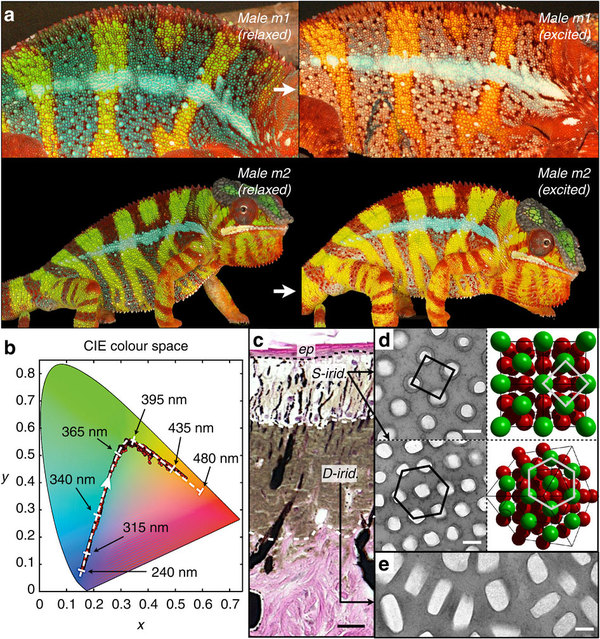So you want to know how the panther chameleon (Furcifer pardalis) changes its skin color? Well, scientists at the University of Geneva in Switzerland
So you want to know how the panther chameleon (Furcifer pardalis) changes its skin color? Well, scientists at the University of Geneva in Switzerland wanted to know also, so they researched how the lizard did and wrote a paper on it. In the Nature Communications paper, lead study author Michel Milinkovitch says that the panther chameleon has two layers of iridophore cells, iridescent cells that are embedded with pigment and also reflect light. These cells are built with nano crystals of varying sizes and shapes and are the building blocks of the chameleon’s capability to change color.
Read More

Nature Communications
Text from Nature Communications: a) Reversible colour change is shown for two males (m1 and m2): during excitation (white arrows), background skin shifts from the baseline state (green) to yellow/orange and both vertical bars and horizontal mid-body stripe shift from blue to whitish (m1). Some animals (m2 and Supplementary Movie 2) have their blue vertical bars covered by red pigment cells. (b) Red dots: time evolution in the CIE chromaticity chart of a third male with green skin in a high-resolution video (Supplementary Movie 3); dashed white line: optical response in numerical simulations using a face-centred cubic (FCC) lattice of guanine crystals with lattice parameter indicated with black arrows. (c) Haematoxylin and eosin staining of a cross-section of white skin showing the epidermis (ep) and the two thick layers of iridophores (see also Supplementary Fig. 1). (d) TEM images of guanine nanocrystals in S-iridophores in the excited state and three-dimensional model of an FCC lattice (shown in two orientations). (e) TEM image of guanine nanocrystals in D-iridophores. Scale bars, 20 μm (c); 200 nm (d,e).
According to the paper, when a male chameleon is not stressed out those cells are in a relaxed state and stay close to each other, but when a male gets excited, such as when another male (or a potentially willing female) comes into the vicinity, the distance between the nano crystals gets further apart, and each cell reflects longer wavelengths, effectively changing the colors to yellow, red or orange. In a relaxed state the chameleon is mostly green.
The full paper can be downloaded from the Nature Communications website.
Teyssier, J. et al. Photonic crystals cause active colour change in chameleons. Nat. Commun. 6:6368 doi: 10.1038/ncomms7368 (2015).


